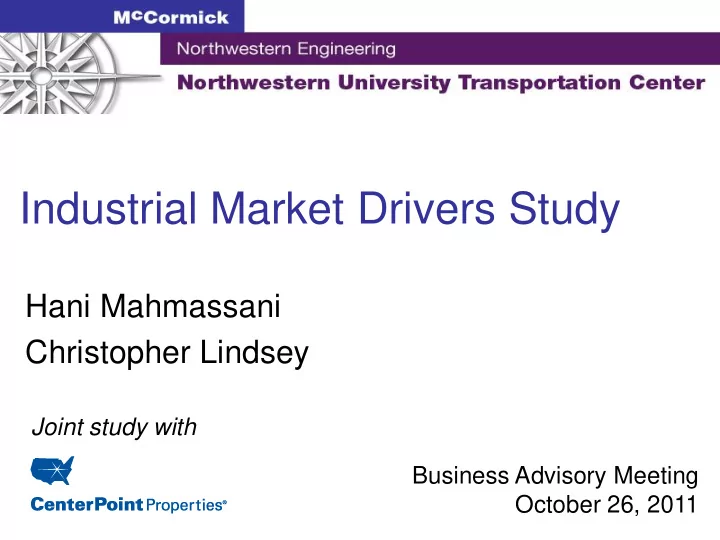

Industrial Market Drivers Study Hani Mahmassani Christopher Lindsey Joint study with Business Advisory Meeting October 26, 2011
Outline • Motivation • Objectives • Methodology • Key Findings
Motivation Identify and quantify factors influencing industrial space demand in metropolitan areas Useful to support planning investments in infrastructure, and formulating real-estate development strategies
Objectives 1. Identify the major economic drivers of industrial space demand and develop an index of industrial market health; 1. Assess the extent to which container flows and/or other measures of freight transportation intensity might lead or lag the demand for logistic-industrial space; and 2. Apply the established relations and/ or indices to help identify likely top markets for industrial space demand. Thesis: Metropolitan areas with significant intermodal and port related infrastructures offer superior industrial real estate investment opportunities .
Methodology • Models were estimated for three measures of demand: net absorption rate, net absorption, and gross absorption • A best model specification was developed for each measure after an exhaustive search through various combinations of variables • Once final models were completed, markets were ranked based on their potential, and a performance index was developed
Analysis Results
Gross Absorption Results Variable Constant -6.1e+03 (-0.8588) Distrb. employment 8.1e+02 (19.5102) Mfg. employment 6.3e+02 (22.6382) Pop. density -3.5e+01 (-14.1312) Metropolitan GDP 3.9e-02 (5.5582) Metropolitan Cons. Expenditures 1.3e+00 (20.2067) % Change in Value of U.S. Imports & 1.2e+03 (17.0736) Exports Inland market TEUs 7.5e+04 (20.5083) Port market TEUs 8.3e+03 (16.5218) No. of Intermodal facilities 5.9e+03 (5.7148) R-squared 0.92118
Example Gross Absorption Plot The final model specification does well in capturing the gross absorption for the Atlanta region
Gross Absorption Marginal Elasticities A change in the amount of TEUs exhibit a pronounced effect on market demand
Key Insights • Macroeconomic, demographic, and transportation variables can be used to capture demand for industrial space • In addition, TEUs have a pronounced effect on demand • Furthermore, the results imply that the number of TEUs are even more important when considering inland markets such as Dallas and Atlanta
Ranking the Metropolitan Areas
Ranking Methodology • The final models were used to forecast gross absorption values through the year 2020 • The normalized sum of gross absorption over the forecast period (2009-2020) was then used to rank each market
Ranking Results Rank Market Combined 1 Chicago 93.48 2 Atlanta 93.25 3 Los Angeles 74.97 4 Houston 53.10 5 Dallas 47.04 6 Riverside 45.20 7 New York 38.31 8 Orange County 37.28 9 Seattle 37.21 10 Boston 36.55 11 Minneapolis 35.23 12 Detroit 34.00 13 Philadelphia 33.94 14 Phoenix 33.26 15 Cincinnati 32.74
Market Performance Index
Creating the Index • Indices of performance for the gross and net absorption models were created • They allow us to gauge each market ’ s performance relative to the performance of historically stellar markets (e.g. Chicago)
Market Comparisons using the Gross Index 150 2003-2008 100 50 0 0 20 40 60 80 100 120 140 Atlanta Boston Chicago Cincinnati Cleveland Dallas Detroit Edison Houston Indianapolis Los Angeles Minneapolis New York Oakland Orange Co. Philadelphia Phoenix Riverside St. Louis Seattle 45-degree Few markets showed relative improvement over the 2003- 2008 period; however, Atlanta stands out.
Market Comparisons using the Gross Index (2) 140 2008-2013 120 100 80 60 40 20 0 0 20 40 60 80 100 120 140 Atlanta Boston Chicago Cincinnati Cleveland Dallas Detroit Edison Houston Indianapolis Los Angeles Minneapolis New York Oakland Orange Co. Philadelphia Phoenix Riverside St. Louis Seattle 45-degree Likewise, few markets exhibit significant improvement in the forecast period except for Atlanta.
Conclusion • The results confirm that there is a positive correlation between gross absorption and intermodal activity. • In addition, macroeconomic and demographic variables strongly correlate with absorption across models. • Transportation variables such as container flows and the amount of intermodal facilities indicate higher absorption values. – This confirms the investment thesis that metropolitan areas that have, or are adjacent to those that have significant intermodal infrastructures offer better investment opportunities.
Acknowledgements Transportation Center, Northwestern University CenterPoint Properties
Recommend
More recommend